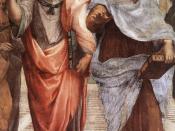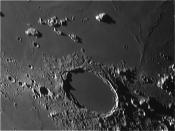Plato's triangular theory of knowledge expounded in "The Republic" has acted as one of the most important contributions in philosophical history - particularly to the field of epistemology. Plato uses three powerful metaphors to explain what knowledge and goodness are: The simile of the sun, the image of the divided line, and the most famous of all, the allegory of the cave. The study of epistemology is primarily concerned with what knowledge is, how it is obtained (if at all), and the validity of it. Plato's contention in The Republic is to show that the world of the forms exists, and it is the true philosophers who have knowledge and should rule the community.
Prior to commencing any discussion of Plato's theory of knowledge it is crucial to outline his concept of the Forms. The Theory of the forms, briefly, states that the material world around us and all its objects are merely reflections of the real world, the world of Forms.
The world of Forms is aspatial and atemporal, it exists in a metaphysical realm of ideas. To exemplify, looking at the screwdriver sitting upon my desk, I am seeing a shadow, a particular instance of the form of screwdriver, in an imperfect state. The form of screwdriver exists metaphysically, it is divine and perfect, eternal and absolute. This method of reasoning about the world around us applies to all objects in the physical world as we 'know' it - they are merely reflections, not the real thing.
Socrates, Plato's main protagonist in The Republic, explains what goodness is to another disciple (Glaucon) using the simile of the sun. The sun is described as providing heat and light to the visible realm. The light allows people to see things and form beliefs through sensory...



Nicely done
i really like your paper, this was a really great essay and it helped me a lot studying. the flow of the paragraphs was very nice and the argumentation was presented very nicely. thank you for posting
0 out of 0 people found this comment useful.